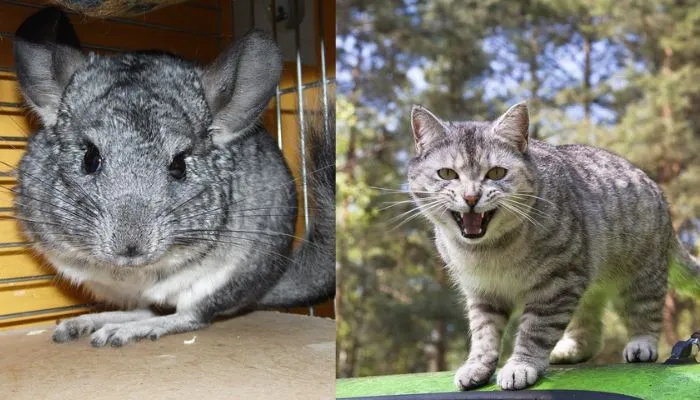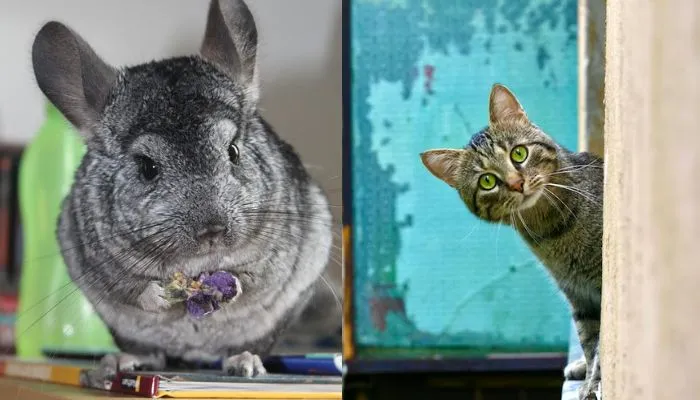Pets bring joy and companionship to our lives. If you’re a chinchilla lover thinking about adding a cat to your family or if you already have both, you’re likely curious about whether these two furry pals can peacefully together. Chinchillas and cats are both known for their charming and endearing qualities. Chinchillas, with their soft fur and playful antics, and cats, with their independent yet affectionate nature, have a way of capturing our hearts. But what happens when these two distinctive personalities collide under the same roof? If you’ve ever wondered about the possibility of chinchillas and cats sharing your home, you’re not alone. In this article, we have discussed how chinchillas and cats live together in one place.
Chinchilla and Cat Behavior:
Understanding the natural behaviors of chinchillas and cats is the first step in determining whether they can live together peacefully or not. Both species have different characteristics and nature that can impact their interactions.
Chinchilla Behavior:
Chinchillas are known for their delicate nature. They’re cautious because, in the wild, they are prey animals. They’re social and playful creatures, always hopping and exploring their surroundings.
Cat Behavior:
Cats are natural hunters, and they can view chinchillas as prey due to their hunting instincts. Cats are territorial and independent animals who like to mark their spaces and do things on their terms.
Chinchillas with Cats: Differences and Similarities
Chinchillas and cats in the same household bring together two unique species with distinct differences and surprising similarities.
Differences:
- Size and Physical Characteristics: Chinchillas are small, rodent-like creatures with soft, dense fur and large ears. Cats, on the other hand, come in various sizes and breeds, from the tiny Singapura to the massive Maine Coon.
- Dietary Needs: Chinchillas have specific dietary requirements, primarily consuming hay, pellets, and occasional treats. Cats are obligate carnivores, meaning their diet consists mainly of animal-based proteins, such as meat and cat food.
- Social Behavior: Chinchillas are social animals that often thrive when they have chinchilla companions. Cats are generally solitary hunters and can be more independent in their behavior.
- Grooming Habits: Chinchillas are known for their dust baths, which help maintain their fur and hygiene. Cats are self-groomers, using their tongues to clean themselves.
- Lifespan: Chinchillas have a relatively long lifespan for small rodents, living around 10-15 years with proper care. Cats’ lifespans vary, but they typically live for 15-20 years or more.
Similarities:
- Nocturnal Behavior: Both chinchillas and cats are crepuscular or nocturnal, which means they are most active during the evening and nighttime.
- Curiosity and Playfulness: Chinchillas and cats share a natural curiosity and playfulness. They enjoy exploring their environment and engaging in activities that challenge their minds and bodies.
- Need for Stimulation: Both chinchillas and cats need mental and physical stimulation to stay happy and healthy. Providing toys and activities is essential for their well-being.
- Potential for Bonding: While the dynamics can be complex, some chinchilla owners have reported successful bonding and companionship between their chinchillas and cats.
Will Cat Attack on Chinchilla?

Cats are natural predators with a strong instinct to chase and catch small, fast-moving creatures. Chinchillas, on the other hand, are small, delicate animals known for their skittish nature. As a result, there is a potential risk that a cat may see a chinchilla as prey and attempt to chase or attack it. Whether or not a cat will attack a chinchilla depends on various factors, including the individual cat’s temperament, the chinchilla’s response, and the specific circumstances. Some cats may exhibit a strong prey drive and be more likely to chase or attack a chinchilla, while others may not display this behavior as prominently.
Risks and Challenges chinchillas get along with cats:
chinchillas and cats in the same household come with certain risks and challenges due to their contrasting natures. Here are some of the potential issues you might encounter when trying to make chinchillas and cats get along:
1. Safety Concerns:
The most significant risk is the cat’s predatory instincts. Cats have an innate drive to chase small, fast-moving creatures like chinchillas, which can lead to attacks and injuries. Chinchillas, being prey animals, are easily stressed by the presence of a cat, and stress can lead to health problems for them.
2. Stress and Anxiety:
Chinchillas can become chronically stressed when they feel threatened by a cat’s presence, impacting their well-being. Cats may also become stressed if they are unable to satisfy their hunting instincts, which can lead to behavioral issues.
3. Aggressive Behavior:
Some cats may view chinchillas as prey, leading to aggressive behavior, such as stalking, pouncing, or swatting. Chinchillas may react to this aggression with fear, which can lead to a cycle of stress and aggression.
Case Studies of Chinchilla and Cats live together:
Sarah has both a chinchilla named Whiskers and a cat named Mittens. Initially, she was concerned about their compatibility. However, Sarah took the time to gradually introduce them and closely supervise their interactions. To her surprise, Mittens displayed curiosity but never aggressive behavior toward Whiskers. Over time, they formed a peaceful coexistence. Sarah attributes their success to patient introductions and ensuring Whiskers had a secure chinchilla-proof enclosure for safety.
Few Steps to Live Chinchillas with Cats:
chinchillas to cats require careful planning and a step-by-step approach to ensure a safe and harmonious coexistence. Here are the essential steps to follow when introducing chinchillas to cats:
1. Create a Safe and Separate Space:
Before introducing your chinchilla to your cat, ensure you have a secure and separate living space for your chinchilla. This will serve as a sanctuary where the chinchilla can retreat if they feel threatened.
2. Gradual Introduction:
Begin by allowing the chinchilla and the cat to become familiar with each other’s scent without direct contact. You can achieve this by swapping bedding or toys between their living areas.
3. Controlled Visual Introduction:
Allow the cat and chinchilla to see each other from a safe distance through a barrier, such as a baby gate or a pet-proofed room with a glass door. Observe their reactions closely.
4. Positive Associations:
During these visual encounters, provide treats or rewards to both the cat and the chinchilla to create positive associations with each other’s presence. This reinforces calm behavior.
5. Leashed Cat Introduction:
If your cat is comfortable wearing a leash and harness, you can try introducing them to the chinchilla in the same room while the cat is on a leash. Keep a firm hold on the leash and closely monitor their interactions.
6. Gradual Freedom:
Over time, as both pets become more comfortable, you can allow the cat to have more freedom while still supervising their interactions. Use treats and positive reinforcement to reward good behavior.
7. Continued Supervision:
Never leave your chinchilla and cat alone together. Continue to supervise their interactions until you are confident that they can coexist peacefully.
8. Chinchilla-Proof Living Space:
Ensure that your chinchilla’s living space is chinchilla-proofed to prevent the cat from gaining access. This includes securing cages, cords, and any potential hazards.
9. Patience and Ongoing Supervision:
Introducing chinchillas to cats can be a slow process, and not all pairs will be able to coexist. Be patient and prioritize the safety and well-being of both pets. If tensions persist, it may be necessary to keep them in separate areas to ensure their comfort and safety. Remember that every cat and chinchilla is unique, and the success of their introduction may vary. Taking these steps can help create a more peaceful environment for both pets and increase the likelihood of successful cohabitation.
Conclusion:
In conclusion, chinchillas and cats can be both challenging and rewarding. The safety and well-being of both pets should always come first. Each pet has its unique personality, and not all will get along. It’s crucial to follow a gradual introduction process, provide separate living spaces, and supervise their interactions carefully. Positive associations and patience can go a long way in helping them coexist peacefully. Remember, every situation is different, and it’s okay if they can’t live together. The primary goal is to ensure the happiness and comfort of both your chinchilla and your cat.










